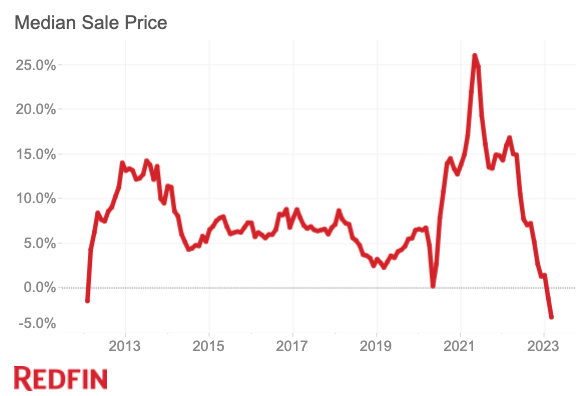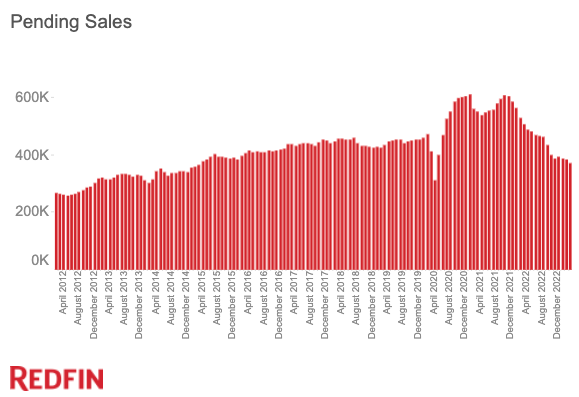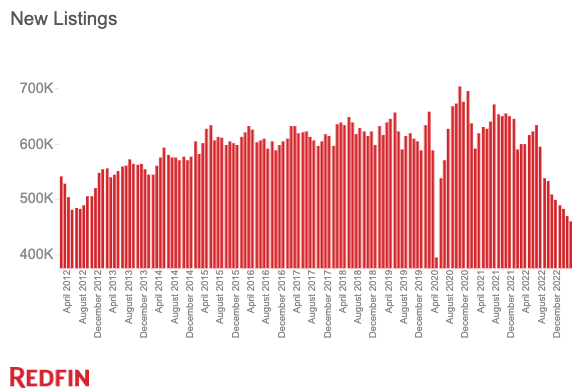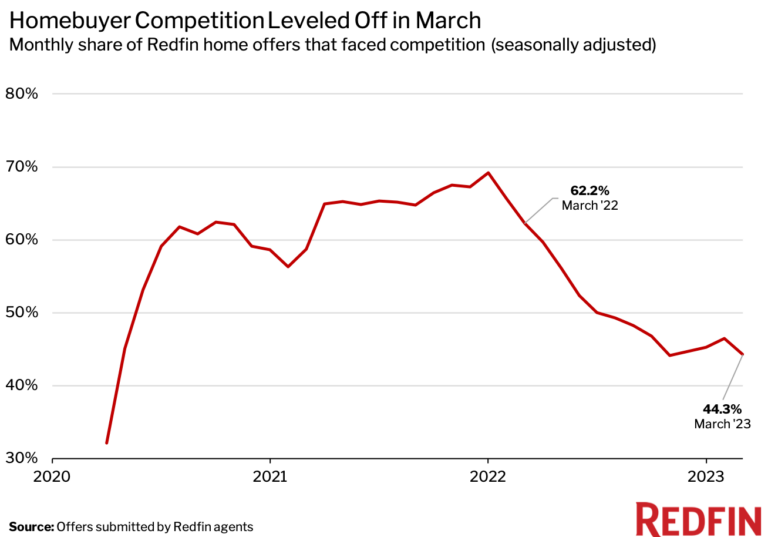According to a new report from Redfin, the median U.S. home sale price fell 3.3% in March to $400,528, representing the largest year-over-year drop since 2012. That follows February’s 1.2% dip, which marked the first annual decrease since 2012.

Pandemic boomtowns and pricey Bay Area markets led the price declines in March. In Boise, ID, prices fell 15.4% from a year earlier, more than any other U.S. metro area Redfin analyzed. Next came Austin, TX (-13.7%), Sacramento, CA (-11.9%), San Jose, CA (-10.5%), and Oakland, CA (-9.7%). Boise also saw the largest drop in pending home sales, with a 78.8% year-over-year decline. Nationwide, pending sales fell 26.6% on a seasonally-adjusted basis to the lowest level since the onset of the pandemic (April 2020).
The dip in pending sales is a major contributor to the dip in home prices; fewer homebuyers mean sellers need to list their homes for less money to attract the house hunters who remain.

“I was consistently busy in the fall, but things got really quiet in March after the collapse of Silicon Valley Bank,” said Boise Redfin Real Estate Agent Shauna Pendleton. “That killed the buyer momentum that had been building and brought us right back to where we were last year when mortgage rates shot up. There’s this fear that everything will crash. There are bank failures, inflation, recession fears, mortgage-rate volatility, a war in Ukraine, spy balloons—some people are wondering if they should pull their money out of the bank and park it in a safe rather than spend it on a new home.”
Just 28.5% of U.S. homes sold for more than their final list price in March, down from 54.1% a year earlier.
Pandemic boomtowns and expensive coastal markets are seeing their housing markets slow quickly because home prices overheated in recent years and are now coming back down to earth after many buyers were priced out. Prices in Boise, for example, surged a record 40.9% in May 2021 as low mortgage rates, remote work and relatively affordable housing brought in scores of homebuyers from more expensive parts of the country. That compares with a national record increase of 26% the same month.

The housing market has slowed from its pandemic peak in Nashville, but demand is stable, according to local Redfin real estate agent Jennifer Bowers. Prices are up about 1% from a year ago and pending sales are down slightly less than the country as a whole.
“Nashville’s housing market is steady,” Bowers said. “We’re still seeing a lot of folks move in from Chicago, Texas, California and Colorado–places people haven’t historically come to Nashville from. Some are moving in for political reasons, some for our low taxes, and many for our relatively affordable home prices. Prices are high in the eyes of many locals, but we’re still affordable compared to a lot of parts of the country. We also have a solid job market and a lot of newly-built houses coming on the market, which is supporting home sales.”
There Aren’t Enough Homes for Sale Even Though Fewer People Are Buying
Elevated mortgage rates are prompting both buyers and sellers to stay put. New listings fell 23.3% year over year in March to the lowest level on record aside from the start of the pandemic on a seasonally-adjusted basis.

Many homeowners are hesitant to sell because moving would mean taking on a higher mortgage rate when they buy their next home. The average 30-year-fixed mortgage rate was 6.54% in March, up from 4.17% a year earlier. Others are staying put because they already bought their dream home in recent years or fear they won’t be able to find another home they like given the shortage of listings.
A lack of homes on the market is contributing to the decline in sales, preventing home prices from falling further and leading to bidding wars in some markets. More than two of every five (44.3%) home offers written by Redfin agents faced competition in March. The bidding-war rate has hovered around that level for the past five months following nearly a year of month-over-month declines.

“One of my sellers recently got multiple offers on their home, but pulled the listing off the market when they found out their interest rate was going to double,” said Bowers, the Nashville agent. “There are a lot of homeowners who don’t want to give up their 2.5% or 3% rate for a 6.5% rate. Both buyers and sellers are having a tough time adjusting because rates are swinging up and down so quickly.”
Roughly 55,000 home-purchase agreements were canceled in March, equal to 14.8% of homes that went under contract. That’s down from the 2022 peak of 16.8% in October but up from 11.2% a year earlier.

“This year’s spring homebuying season is lackluster,” said Redfin Chief Economist Daryl Fairweather. “There are some signs of the typical seasonal uptick—homes are selling faster than they were in the winter—but that’s partly because there are so few new listings. Normally we see homebuyers come out in throngs at this time of year, which isn’t happening.”
Click here to read more on Redfin's analysis of March 2023 home sale prices.

 DSNews The homepage of the servicing industry
DSNews The homepage of the servicing industry









